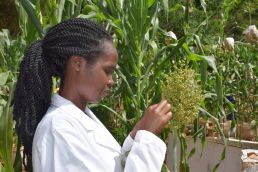Dr Sylvia Mutinda is a scientist from Kenya who works on a parasitic plant, Striga hermonthica, that infests crops in Africa. She will be coming to work on Striga in the Lumba lab in Toronto with the aid of a Provost Post-doctoral Fellowship from the University of Toronto.
Prof Shelley Lumba in the Department of Cell & Systems Biology (CSB) studies the chemical signals that are released into soil by plants, which is one way they communicate with each other. Healthy sorghum plants, for example, release these signals to indicate to other sorghum seedlings that conditions are good for growth. Striga seeds have evolved to sense these signals and use them to sprout.
Dr Mutinda has identified unique sorghum varieties that are resistant to Striga and will be working with CSB scientists to determine what chemical signal allows this variety to be resistant, so that the resistant trait can be isolated and used to develop resistant crop plants.

When a crop like sorghum or rice starts to grow, Striga seeds can sprout in adjacent soil, and their roots dig into crop roots to steal nutrients and water directly from the sap. This process fascinates Dr Mutinda, and she became skilled at the histology of distinguishing parasite cells (P) from host cells (H). She became passionate about combating Striga when she witnessed the emergence of Striga’s beautiful but sinister purple flowers during field studies.
“As a research assistant with Professor Steven Runo and Dr. Jacinta Kavuluko, I participated in a number of trips to Western Kenya. That’s when I had the opportunity to appreciate the adverse effects that Striga has on its hosts,” Dr Mutinda explains. “I could see school age children unable to attend school as they’re busy weeding for Striga. And these are some of the regions that are really poverty stricken in Western Kenya.”
One way sorghum crops can resist Striga is by changing the signal that promotes sorghum growth so Striga cannot detect it. This trait is known as pre-germination resistance. This chemical signal detected by Striga is called strigolactone, and two of the most studied isomers are 5-deoxystrigol and orobancol.
Normally, pre-germination resistant strains produce orobancol, but Dr Mutinda was surprised to find that one of her resistant strains produced 5-deoxystrigol. She reasoned there could be another interacting compound mediating resistance. Since there can be multiple chemicals exuded by the plant root, she worked in collaboration with Professor Salim Al Babili to test her strain’s root exudate for a second compound, ABA, which is also associated with resistance.
Dr Mutinda was puzzled to find that ABA was not a significant component of the root exudate. However, this is an exciting finding since identifying a new naturally-produced Striga resistance chemical from her strain could be a breakthrough for preventing Striga infestation.
The Lumba lab has a synthetic biology assay that detects strigolactone. Dr Mutinda will exploit this assay by testing fractions containing the different compounds in the root exudate of her resistant strain.
A second resistance mechanism is post-attachment resistance, which comes through different modes, such as cell wall reinforcements to resist penetration, or localized death of infected cells through hypersensitive response.
In gene expression studies with Professor Runo, Dr Mutinda found that resistant sorghum express genes for multiple resistance modes in contrast to the commonly held narrative that one mode of resistance dominates. These crops had evolved so that if, for example, pre-germination resistance was insufficient, the plants could still deploy post-attachment resistance genes.
Dr Mutinda will be using her skills in gene expression analysis from this study complemented with the Lumba lab synthetic biology assay to study fungal responses to sorghum exudates. She is looking forward to experimenting with the Lumba Nanopore sequencer, as it is also possible to conduct experiments with this palm-sized genome sequencer in crop fields. At Prof Lumba’s lab, Dr. Mutinda will acquire high-level skills in a range of disciplines from ‘omics’, genetics, and biochemistry.
Dr Mutinda has been reading up on Toronto from her lab in Kenya. “I have learned that Toronto is a multicultural city, “says Dr Mutinda. “So, I am really looking forward to interacting with people from diverse cultures and enjoy their cuisines and get to learn more from them. I can’t wait to explore the treasures in the heart of downtown Toronto among them, concerts at Roy Thompson Hall.”
Congratulations to Dr Mutinda on earning a Provost Post-Doctoral Fellowship and we’re happy to welcome you to Toronto!

